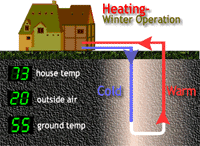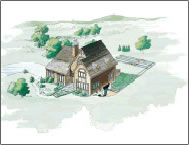Why Choose C & S to install your geothermal system?
With a combined 30 years of geothermal experience you get the best combination of design, installation, and service for your geothermal system in Nashville, or anywhere in the middle TN area. From the smallest to the largest jobs we can find the right fit for your business or home.
How It Works: Anatomy of a Geothermal Heat Pump
You already have a heat pump in your home – your refrigerator. If you put your hand behind it, you’ll feel the heat that’s being pumped from the inside.
It’s the same principle that a geothermal heat pump uses to warm your home. Instead of producing heat like a conventional furnace, a geothermal heat pump moves heat from one place to another – from the ground into your home.
What It Is: The Geothermal Process
The geothermal process is based on a simple premise: Below the frost line – usually about six feet deep – the earth is a constant temperature of about 50 degrees Fahrenheit all year long.
During the winter, the heat pump absorbs heat from the ground and uses it to warm the air in your home. In the warmer summer months, the processed is reversed, taking heat from your home and transferring it back into the ground.
The basic elements of a geothermal system include:
- Underground loops of plastic piping
- A liquid antifreeze solution
- A heat pump
- An air distribution system
The loops of piping are buried in the ground near your home or business, either vertically or horizontally. That ground loop is connected to a pumping module inside your home.
The pump circulates a mixture of water and the antifreeze through the ground loop, where it absorbs heat from the earth.
When the heated liquid reaches the heat pump inside your home, the heat is multiplied and used to warm the air inside the air-handling system. A blower sends the warmed air throughout the building through ductwork.
Vertical Loops are used extensively where land area is limited or soil conditions prohibit digging the more economical horizontal loops. A pair of pipes with a special U-Bend assembly at the bottom are inserted in a bore hole that averages between 150 to 250 feet deep per ton of equipment. These holes are then backfilled with a special grout solution to ensure good contact with the earth.
Horizontal Loops are installed in areas where the soil conditions allow for economical excavation. Taking up more land area than any other loop type, they are used where space permits. Trenches are normally about five foot deep with multiple pipes places in the trench at different depths. Normally, several hundred feet of trench is required, but where space permits these loops are considered desirable.
Pond Loops are usually very economical to install. If a pond or lake at least eight feet deep is available, pond loops can utilize the water (rather than soil) to transfer heat to and from the pond. A Coiled pipe is placed in the water which should cover about 1/2 acre. An average home would require about 900 feet of pipe. Reduced installation costs and high performance are characteristic of this type of loop.
Open Loop installations actually pump water from an underground aquifer through the geothermal unit and then discharge that water to a drainage ditch or pond. The geothermal unit processes the heat energy from the water just ilk a closed loop installation. Discharging water to a “return” well is sometimes effective, but sending water to a pond or lake is considered more reliable.
Please be sure to check out our News & Tips Section on this website for the latest in GEOTHERMAL NEWS.




